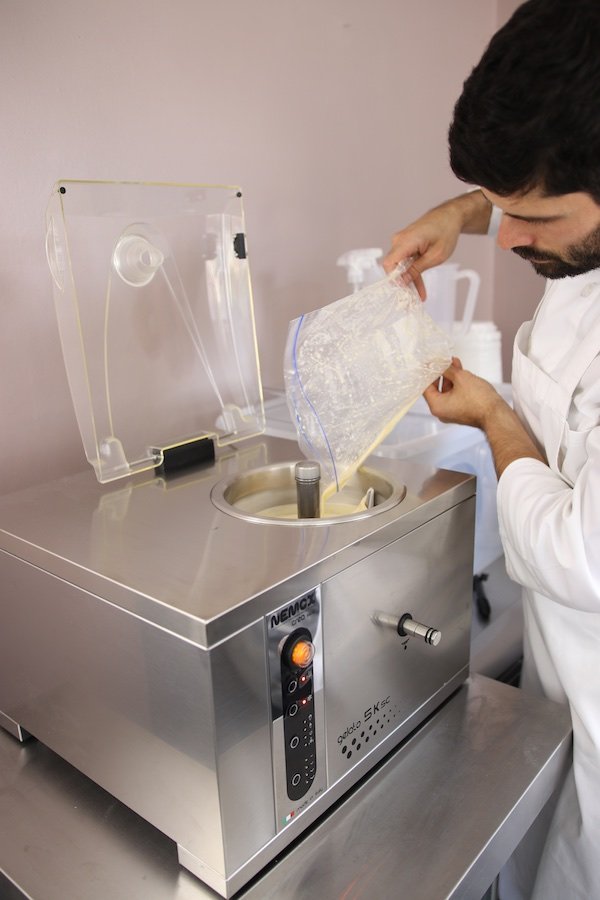27 MINUTE READ 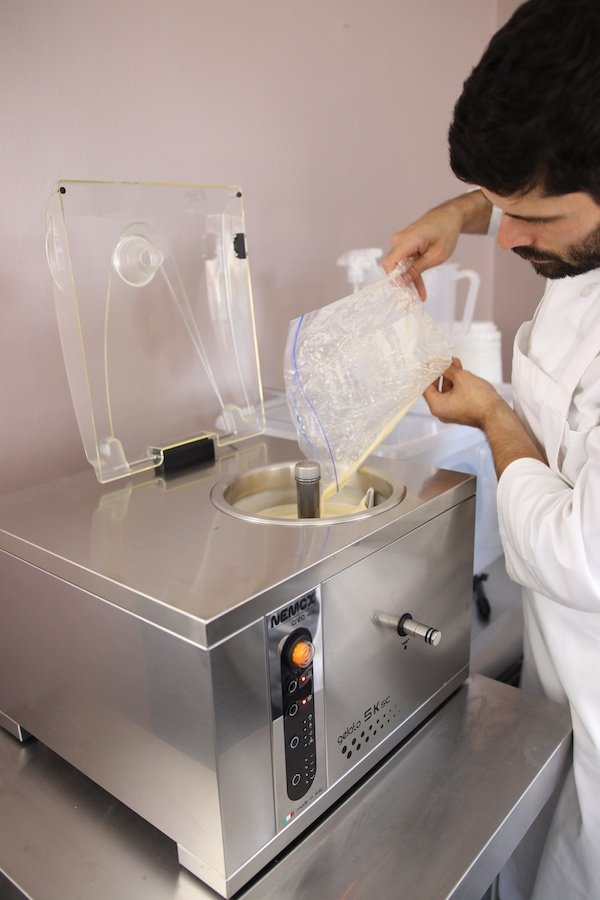 I've been testing the Nemox 5K Crea, available from [amazon text=amazon*&asin=B01CJC9G06&asin[uk]=B01LY9N0RM&asin[de]=B00K7CA2YA&asin[it]=B00K7CA2YA], for close to a month now and have found that it makes exceptional ice cream that is extremely smooth, dense, and creamy. The dasher rotates at a relatively low 70 revolutions per minute (rpm), resulting in dense ice cream with about 7% air. It has a maximum capacity of 1.25kg, 1120 ml (1.18 quart), of ice cream mix, producing about 1200 ml (1.27 quart) of ice cream in 12 minutes, although I have managed to freeze 1527g, about 1500ml (1.59 quart) of ice cream mix, producing about 1600ml (1.69 quart) of ice cream with about 7% air in 15 minutes. It can make both ice cream and gelato, freeze batches back-to-back, and is very easy to clean. My only complaint is that the dasher could do a better job at dispersing the ice cream as it freezes in the barrel. You can view the top selling ice ice cream machines on amazon by clicking here*.
I've been testing the Nemox 5K Crea, available from [amazon text=amazon*&asin=B01CJC9G06&asin[uk]=B01LY9N0RM&asin[de]=B00K7CA2YA&asin[it]=B00K7CA2YA], for close to a month now and have found that it makes exceptional ice cream that is extremely smooth, dense, and creamy. The dasher rotates at a relatively low 70 revolutions per minute (rpm), resulting in dense ice cream with about 7% air. It has a maximum capacity of 1.25kg, 1120 ml (1.18 quart), of ice cream mix, producing about 1200 ml (1.27 quart) of ice cream in 12 minutes, although I have managed to freeze 1527g, about 1500ml (1.59 quart) of ice cream mix, producing about 1600ml (1.69 quart) of ice cream with about 7% air in 15 minutes. It can make both ice cream and gelato, freeze batches back-to-back, and is very easy to clean. My only complaint is that the dasher could do a better job at dispersing the ice cream as it freezes in the barrel. You can view the top selling ice ice cream machines on amazon by clicking here*.
My Review Method
I've used a slightly unconventional method of review. Let me explain. The best ice creams in the world have a smooth and creamy texture. This texture, primarily associated with a high milk fat content, is also determined by the average size of the ice crystals: smooth and creamy ice cream requires the majority of ice crystals to be small. If many crystals are large, the ice cream will be perceived as being coarse or icy.Because ice crystal size is a critical factor in the development of smooth texture, I've discussed the key principles that underpin ice crystal formation and growth, and how these principles are affected by the features of the Nemox 5K Crea. By having an understanding of these key principles, I hope that you'll be in a better position to evaluate this machine. If you're short on time, you can skip to the Summary of this review. If you fancy a nice long read, then sit back, grab yourself a hot cup of cocoa, and the enjoy this comprehensive review. :)[toc]
1. Ice Crystals in Ice Cream
Ice crystals range in size from about 1 to over 150 μm in diameter, with an average size of about 25 μm in commercial ice cream (Berger et al., 1972; Caldwell et al., 1992; Donhowe & Hartel, 1996; Hagiwara & Hartel, 1996; Hartel, 1996; Koxholt et al., 2000; Marshall et al, 2003; Sofjan & Hartel, 2004; Inoue et al., 2008; Kusumaatmaja, 2009). Small ice crystals, around 10 to 20 µm in size, give ice cream its smooth and creamy texture, whereas larger ice ice crystals, greater than 50 μm, impart a grainy texture (Marshall et al., 2003; Eisner et al, 2005; Drewett & Hartel, 2007). To produce ice cream with the smallest possible ice crystals, it’s important to develop an understanding of ice formation (known as crystallisation) during the freezing of ice cream.
Ice cream is frozen in two stages, the first being a dynamic process where the mix is frozen in a scraped-service freezer (SSF) (an ice cream machine) whilst being agitated by the rotating dasher, a mixing device with sharp scraper blades attached, to incorporate air, destabilise the fat, and form ice crystals. Upon exiting the SSF, the ice cream, at about -5°C to -6°C (23°F to 21.2°F) and with a consistency similar to soft-serve ice cream, undergoes static freezing where it is hardened in a freezer without agitation until the core reaches a specified temperature, usually -18°C (-0.4°F). Cook & Hartel (2010) argue that the dynamic freezing stage is arguably the most important step in creating ice cream because this is the only stage in which ice crystals are formed.
1.1 Nucleation
During dynamic freezing, the ice cream mix is added to the SSF at between 0°C and 4°C (32°F and 39.2°F). As the refrigerant absorbs the heat in the mix, a layer of water freezes to the cold barrel wall causing rapid nucleation, that is the birth of small ice crystals (Hartel, 2001). For smooth and creamy ice cream, it’s important to have a high rate of nucleation so as to form as many small ice crystals as possible (Hartel, 1996). The more ice crystals that are formed during dynamic freezing, the more will be preserved during static freezing, resulting in a smaller average crystal size and smoother texture (Cook & Hartel, 2010).
1.2 Growth and Recrystallisation
The crystals that form at the cold barrel wall are then scraped off by the rotating scraper blades and dispersed into the centre of the barrel, where warmer mix temperatures cause some crystals to melt and others to grow and undergo recrystallisation. Recrystallisation is defined as “any change in number, size, shape, orientation or perfection of crystals following completion of initial solidification” (Fennema, 1973). The greater the extent of growth and recrystallisation in the centre of the barrel, the larger the ice crystals will be. Russell et al. (1999) found that crystallisation during the freezing of ice cream is dominated by recrystallisation and growth and that these mechanisms appear to be more important than nucleation in determining the final crystal population.
2. Factors Affecting Nucleation, Growth, and Recrystallisation
2.1 The Scraper Blades
Nucleation is affected by the rate of heat transfer from the mix to the cold freezer barrel, with a high rate of heat transfer promoting a high rate of nucleation (Hartel, 1996; Goff & Hartel, 2013). Because heat travels more slowly through ice than stainless steel, ice build up on the freezer barrel wall acts as an insulator and lowers the rate of heat transfer.
Keeping the scraper blades sharp and close to the barrel wall helps promote a high rate of heat transfer by scraping off any ice that forms at the barrel wall (Goff & Hartel, 2013). Ben Lakhdar et al. (2005) found that a large gap between the scraper blades and the barrel wall slowed heat transfer. This was attributed to a permanent ice layer, which forms between the blades and the wall only when the gap is high enough (3mm). When the gap is 1mm, the ice layer is not strong enough and is periodically removed from the wall.
Does the Nemox 5k Crea leave a gap between the scraper blades and the barrel wall?
The Nemox 5K Crea comes with a heavy stainless steel dasher that has 2 protruding arms. Attached to these arms are 2 alimentary plastic scraper blades, which clip on and off very easily for cleaning; I also got a spare pair of blades with my machine. When the dasher is slid onto the transmission shaft inside the barrel, the blade on the longest arm sits against the barrel wall, and the blade on the shortest arm against the bottom of the barrel. Both blades sit firmly against the barrel without leaving a gap, thereby promoting efficient heat transfer during dynamic freezing.
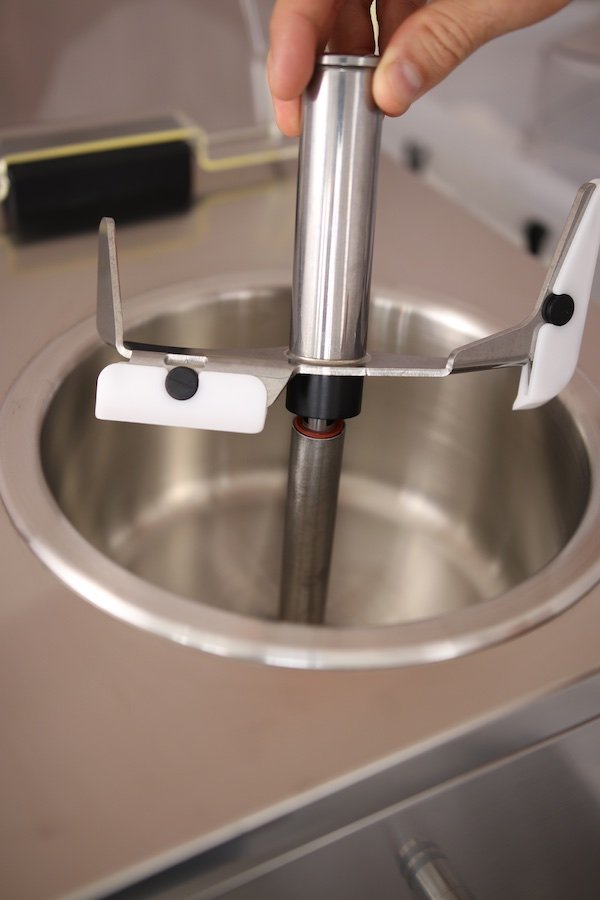
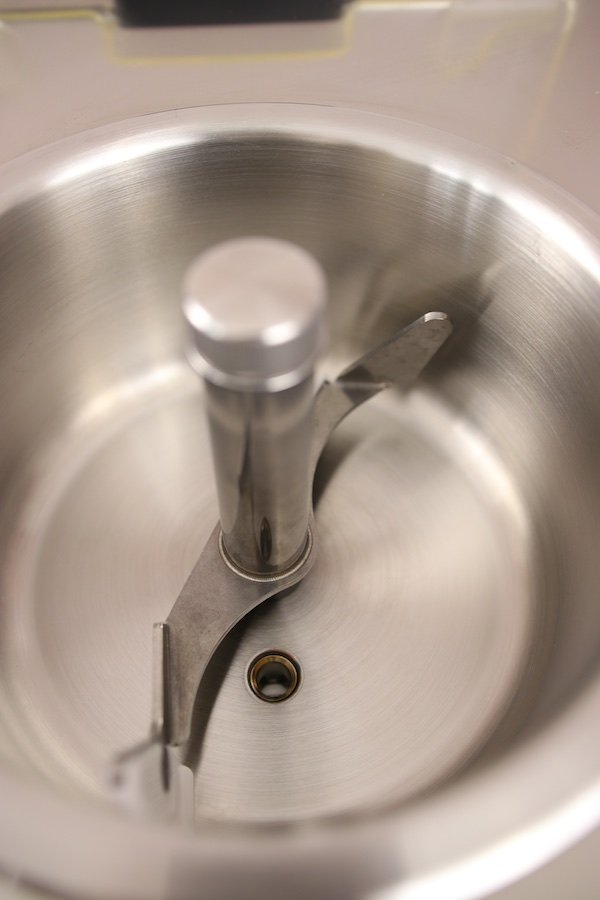
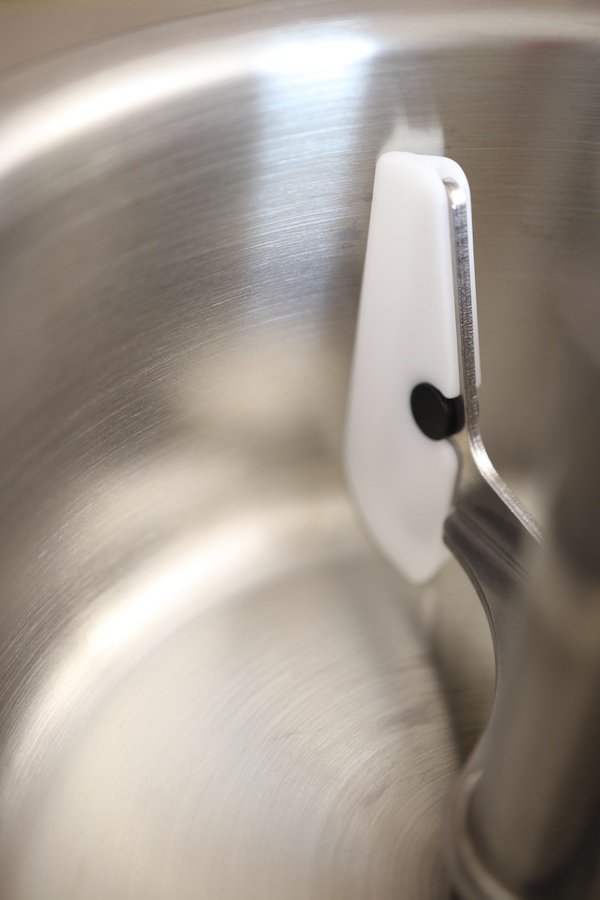
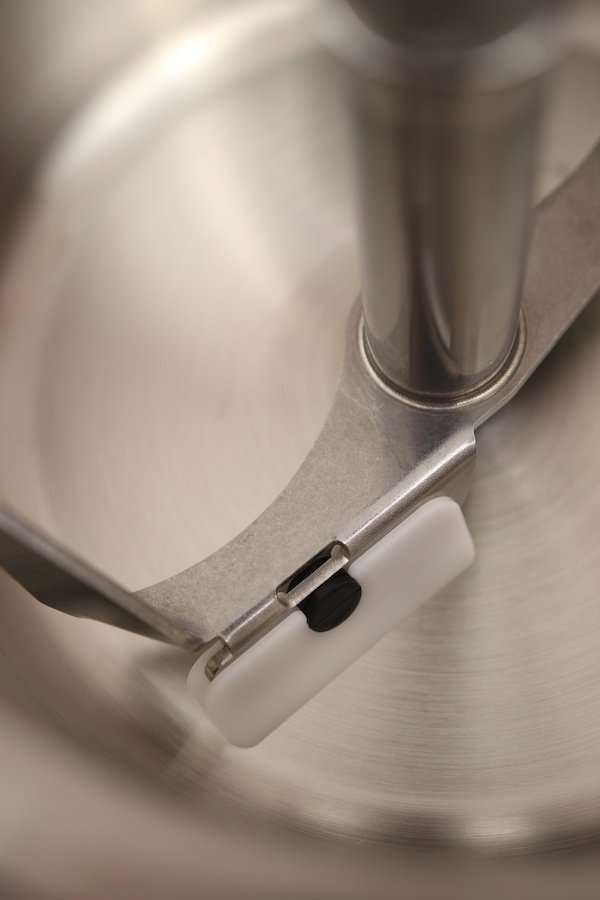 2.2 Air In Ice Cream
2.2 Air In Ice Cream
The amount of air incorporated into a mix during dynamic freezing, referred to as the overrun, affects the size of the ice crystals, with slightly larger ice crystals observed at a lower overrun (Arbuckle, 1977; Flores & Goff, 1999b). Flores and Goff (1999a) suggested that overrun below 50% does not influence ice crystal size, but the amount of air cells at 70% overrun is just enough to prevent collisions among ice crystals, which can result in an increase in crystal size. Sofjan & Hartel (2004) found that increasing the overrun in ice cream (from 80% to 100% or 120%) led to the formation of smaller ice crystals, although the effect was relatively small.
How much air does the Nemox 5K Crea whip into ice cream?
The dasher on the 5K Crea rotates at a relatively low 70 rpm, compared to typical speeds of 100-200 rpm in commercial machines. I've found that this produces extremely dense ice cream with about 7% air when 1.25kg, 1120 ml (1.18 quart), of mix is frozen, and about 10% air for 1187g, 1095ml (1.16 quart), of ice cream mix. This compares to about 60% air incorporated by my Emery Thompson CB-200, which produces ice cream that is lighter and airer. Despite slightly larger ice crystals being observed in ice creams with a lower overrun, I personally prefer the denser, chewier texture that results from a low overrun.
Does the Nemox 5K Crea make gelato?
Yes, the Nemox 5k Crea does make gelato. Italian-style ice cream is referred to as gelato, the Italian word for ice cream. There are, however, significant differences between traditional gelato and regular ice cream: gelato is typically lower in milk fat (4-8% in gelato, 10-18% in ice cream), total solids (36-43% in gelato, 36->40% in ice cream), and air (20-40% in gelato, 25-120% in ice cream) but higher in sugar (up to 25% in gelato, 14-22% in ice cream) (Goff & Hartel, 2013). Gelato also tends to be softer, more pliable and stickier than ice cream, and is served at warmer temperatures. Because the Nemox 5K Crea incorporates between 7-10% air, well below the typical 20-40% range for gelato, as long as you use a gelato recipe, it will happily produce gelato.
2.3 The Freezer Barrel Wall Temperature
The temperature at the freezer barrel wall has also been found to affect the rate of nucleation and recrystallisation. Drewett & Hartel (2007) found that decreasing the coolant temperature at the freezer barrel wall caused higher ice crystal nucleation rates and reduced recrystallisation in the warmer bulk mix, which helped the ice crystals remain small. Similarly, Russell et al. (1999) found that as the freezer barrel temperature was lowered, the nucleation rate increased accordingly. Cook & Hartel (2011) simulated ice cream freezing in an ice cream machine by freezing ice cream mix in a thin layer on a microscope cold stage. The temperature at which ice cream mix was frozen on the cold stage varied from -7, -10, -15, and -20°C (19, 14, 5, and -4°F). They found that warmer freezing temperatures gave more elongated and slightly larger crystals with a wider size distribution.
To promote rapid nucleation and minimise recrystallisation, the temperature of the refrigerant, which is R404a in the Nemox 5K Crea, should fall within the range of -23°C to -29°C (-10°F to -20°F) (Goff & Hartel, 2013), with the freezer barrel wall temperature estimated to be a few degrees warmer.
How cold does the barrel get?
I've found that the freezing system in the Nemox 5K Crea is able to get the freezer barrel wall temperature down to -29°C (-20.2°F) when empty. This compares to a freezer barrel wall temperature of -32°C (-25.6°F) in my Emery Thompson CB-200.
Is the barrel removable?
Nope. The Nemox 5K Crea has a 3.2 litre (3.38 quart) non-removable 304 stainless steel barrel that is vertically set into the housing unit. I haven't had any issues with using or cleaning this non-removable barrel.
2.4 Draw Temperature
The draw temperature is the temperature at which ice cream is removed from the barrel once dynamic freezing is complete. In commercial machines, this is usually -5°C to -6°C (23°F to 21.2°F) (Goff & Hartel, 2013). Draw temperature significantly influences mean ice crystal size because it determines how much water is frozen during dynamic freezing and, consequently, how many ice crystals are formed. Caillet et al. (2003) found that decreasing the draw temperature resulted in more water being frozen and increased ice crystal content. The more ice crystals that are formed during dynamic freezing, the more will be preserved during static freezing, resulting in a smaller average crystal size and smoother texture (Cook & Hartel, 2010). Drewett & Hartel (2007) showed that ice crystals were larger at draw temperatures from -3°C to -6°C (26.6°F to 21.2°F). When the draw temperatures were colder than -6°C (21.2°F), the mean ice crystal size decreased.
Low Temperature Extrusion
Bolliger (1996) and Windhab et al. (2001) investigated the influence of Low Temperature Extrusion (LTE) freezing of ice cream, where ice cream exiting the SSF at -5°C to -6°C (23°F to 21.2°F) is frozen further to about -13°C to -15°C (8.6°F to 5°F) in an extruder with slowly rotating screws, on the ice crystal size in comparison to conventional draw temperatures. It was shown that the mean ice crystal size was reduced by a factor of 2 by means of the LTE process compared to conventional freezing. Sensorial properties like consistency, melting behaviour, coldness, and scoopability also showed clearly improved values (Windhab, 2001).
Besides the ice crystal size, the size and distribution of air cells and fat globules are of primary importance, especially on the sensorial aspect of creaminess. To obtain creamier ice cream, it's important to generate ice crystals, air cells, and fat globule aggregates as small as possible (Wildmoser et al., 2004). LTE helps to prevent air bubbles from coming together, thereby retaining the smallest size distribution (Eisner et al., 2005). Air Bubbles in the 10-15 μm range have been reported in LTE frozen ice cream, compared to conventionally frozen ice cream samples with bubbles in the 40-70 μm range (Bolliger et al., 2000b). LTE also helps to reduce the size of agglomerated fat globules compared to conventionally frozen ice cream (Windhab & Bolliger, 1998a, b). Furthermore, LTE generally promotes enhanced fat destabilisation, which is partially responsible for slow melting and good shape retention (Bolliger et al., 2000b). The percentage of the fat droplets destabilisation in the LTE treated ice cream can be twice that achieved during the conventional freezing process (Soukoulis & Fisk, 2016).
Because of smaller air bubble and fat globule aggregates sizes, as well as a higher degree of foam stability (fat globule destabilisation), LTE ice cream is evaluated creamier than conventionally produced ice cream (Wildmoser et al., 2004). What I've found during testing is that ice cream extracted at draw temperatures of around -12.1°C (10.22°F) is indeed perceived as being slightly creamier than that extracted at conventional draw temperatures of around -6°C (21.2°F).
Vertical Barrels vs Horizontal Barrels
What I've learnt from operating my Emery Thompson CB-200 this summer is that ice cream frozen in an ice cream machine with a horizontal barrel is limited to draw temperatures of between -5°C to -6°C (23°F to 21.2°F); lower draw temperatures produce stiffer ice cream that does not flow readily and therefore can't be conventionally extracted through the opening in the front plate. Instead, the front plate has to be unscrewed and the remaining ice cream scooped out. At a draw temperature of -3°C (26.6°F), I've found that about 8% of the mix, about 211g of a 2496g mix, remains in my CB-200 after conventional extraction. At a draw temperature of -7°C (19.4°F), however, I've found that about 39% of the mix, about 900g of a 2303g mix, remains in the barrel after conventional extraction.One advantage of the vertical barrel in the 5k Crea that I've found is that it's able to freeze ice cream to a low draw temperature of -12.1°C (10.22°F), which can then be easily extracted by lifting the hinged lid and scooping with a large spoon. I've found that between 9% and 15%, 113g and 188g, of a 1.25kg mix remains in the barrel after extraction, mostly stuck to, or under, the dasher.
Extraction Time
I've also learnt that wastage is an inevitable part of the ice cream making process; it's impossible to extract every last gram from the barrel. During extraction, it's important to balance trying to minimise wastage with minimising the extraction time. The longer it takes to extract ice cream from the barrel and get it into a freezer for static hardening, the longer it spends at relatively warm room temperatures where recrystallisation and growth occur very rapidly. The greater the extent of recrystallisation and growth, the larger the ice crystals are likely to be. It takes me about 1 minute and 30 seconds to extract my ice cream from the 5K Crea. I've found that switching the compressor off during extraction makes things easier.
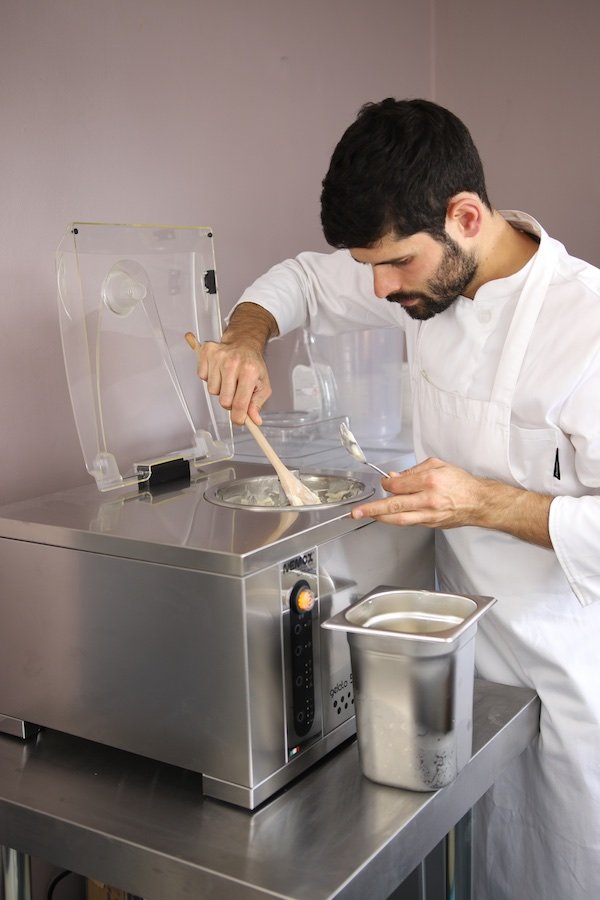 2.5 Residence Time
2.5 Residence Time
Residence time, which refers to the length of time ice cream spends in the barrel and takes to reach its draw temperature, has a significant effect on the final ice crystal size distribution, with shorter residence times producing ice creams with smaller ice crystals due to a decline in recrystallisation (Russell et al., 1999; Koxholt et al., 2000; Goff & Hartel, 2013; Drewett & Hartel, 2007; Cook & Hartel, 2010). Longer residence times mean that ice cream spends more time in the bulk zone of the barrel where warmer temperatures cause rapid recrystallisation. Donhowe & Hartel (1996) measured a recrystallisation rate at -5°C (23°F) of 42 μm/day. At this rate, a size increase of around 8 μm would be expected over a 10 minute period. This matches almost exactly the increase in crystal size observed by Russell et al. (1999) at a slightly different temperature of -4°C (24.8°F). Clearly, the longer ice cream remains in the barrel at temperatures where recrystallisation occurs very rapidly, the greater the extent of recrystallisation and the larger the ice crystals.
A high rate of heat transfer and colder barrel wall temperatures contribute significantly to shorter residence times. Lower barrel wall temperatures lower the bulk temperature of the ice cream faster, reducing residence time and improving the ice crystal size distribution (Russell et al., 1999; Drewett & Hartel, 2007). Investigating the effect of draw temperature, dasher speed, and residence time on ice crystal size, Drewett & Hartel (2007) concluded that residence time had the greatest impact on final crystal size distribution, followed by drawing temperature and dasher speed.
How long does the Nemox 5K Crea take to freeze a batch of ice cream?
I've found that it takes an impressive 12 minutes to freeze a 1.25kg, 1120 ml (1.18 quart), batch of ice cream to a draw temperature of between -10°C and -12.1°C (14°F and 10.22°F).
How much ice cream does the Nemox 5K Crea make?
Although the instruction manual states that the maximum ingredients quantity is 1.25 kg, 1120 ml (1.18 quart), of ice cream mix, I've managed to freeze 1527g, about 1500ml (1.59 quart), of ice cream mix, producing about 1600ml (1.69 quart) of ice cream with about 7% air. This bigger batch did, however, require an increased residence time of 15 minutes to achieve a draw temperature of between -8.6°C and -11.3°C (16.5°F and 11.66°F).
Can the Nemox 5K Crea make 1 quart or less test batches?
Yes I've found that the 5K Crea is able to freeze 617g, just under 500ml (0.53 quart), test batches, which is useful when testing new recipes. It took me 8 minutes to freeze 617g of ice cream mix to a draw temperature of between -11°C and -14°C (12.2°F and 6.8°F), which had the same thick and creamy consistency as the the larger 1.25kg, 1120 ml (1.18 quart), batches.
Can the Nemox 5K Crea freeze batches back-to-back?
Yes it can freeze batches back-to-back. To test this, I froze 5 batches each weighing 1.25kg, 1120 ml (1.18 quart), back-to-back. Each batch had a residence time of 13 minutes and was extracted at a draw temperature of -8°C to -11°C (17.6°F to 12.2°F). The machine was in near continuous use for 1 hour and 15 minutes, with the freezing system and dasher switched off for about 2 minutes between each batch to allow for extraction. The freezing system did not overheat, nor did batches take progressively longer to freeze
Automatic Mode
The Nemox 5K Crea has a series of programs which automate the freezing process. This means that the dasher stops rotating after the ice cream mix has frozen to a pre-set consistency. These programs are classic Italian gelato and sorbet; semi-soft gelato; granita; and the fast cooling program. The latter is used to quickly cool mixes after pasteurisation. There are also 4 preservation cycles available for each of the automatic freezing modes (total of 16 cycles) that keep frozen ice cream at a constant temperature after freezing. I haven't yet tried these automatic or preservation programs because I prefer to control the freezing stage myself.
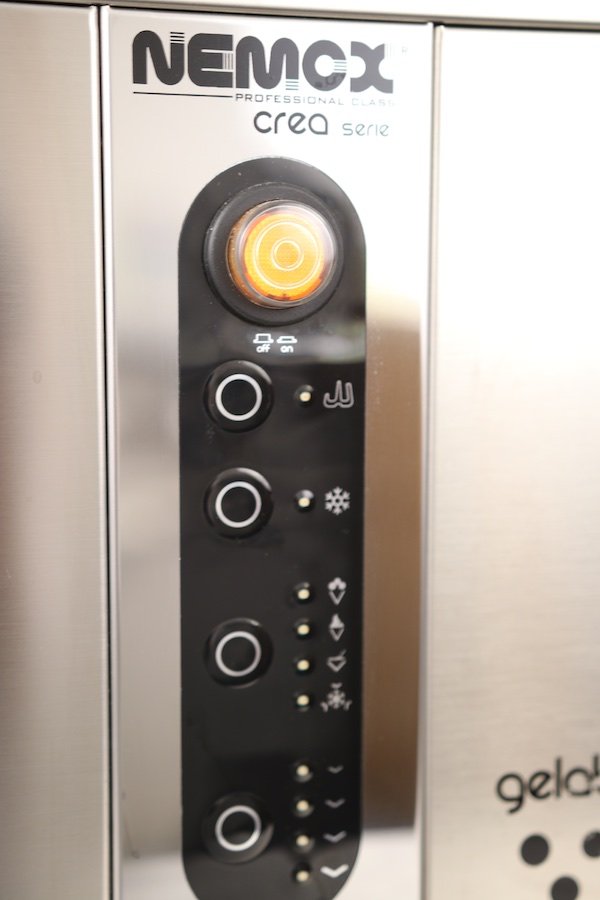 3. General Questions
3. General Questions
What are the dimensions, Weight, and Voltage?
The Nemox 5k Crea measures 465mm (18.3") in width, 480 (18.9") mm in depth, and 395 mm (15.6") in height, and weighs 34 kg (75 pounds). I needed help getting it onto my table when it arrived and wouldn't say that it's a machine that can be easily moved. Here in the U.K, it runs on 220-240v 50Hz single phase electrical power, which means it can be plugged into a standard 3 pin plug and doesn't require 3-phase power. In the U.S it's 120v 60Hz. It draws 650 watts and is air cooled.
What is the Warranty?
Here in the U.K, it has a 1-year manufacturer's warranty against defects in material or workmanship. On-site warranty repair is included in the warranty. I contacted amazon regarding the warranty in the U.S and received this reply:Eligible warranty for Nemox home equipment is handled by 1st-line Equipment or representative thereof. If you have purchased your equipment from another retailer (not 1st-line Equipment), you must contact them first in order to get your equipment serviced under warranty. The warranty is limited to manufacturer's defects only. The manufacturer's warranty is good for a period of 1 year from date of receipt, which covers parts. Labor warranties may vary depending on the company you purchase from. Nemox products may have an extended warranty limited to manufacturer's defects and will specifically state the extended period of time on your receipt. In most cases, your Nemox equipment must be sent to a repair facility. If you are getting your equipment serviced by 1st-line Equipment, you must either ship it or drop off at our facility in New Jersey.
Maintenance
The instruction manual advises that the ventilation grids on the rear and the bottom of the machine be cleaned at least once a year. It also states that the oil seal on top of the transmission shaft in the centre of the barrel be checked regularly (at least once every 3 months). If necessary, it is to be replace or lubricated with H1 category grease or higher. I got an oil seal replacement supplied with my machine.
Is it Noisy?
This machine is incredibly quiet . It produces 83 dB of noise when in operation and I haven't had any problems with sitting in the room with it in operation.
Is it easy to clean?
Besides the incredibly dense and creamy ice cream, the feature I have been most impressed by is the small drainage hole inside the barrel, which makes cleaning very quick and easy. To clean the barrel, I fill it with about 1 litre (1.06 quart) of boiling water, place a 2 litre (2.1 quart) bowl under the drain pipe located on the front panel, and then drain the diluted ice cream mix by removing the long drain plug that covers the drainage pipe. I then remove the dasher and scraper blades and use a sponge and detergent to wipe the barrel, before rinsing 2-3 times more with boiling water. After sanitising and rinsing, I use kitchen towels to dry the barrel, and insert the washed plug back in the drain pipe. Cleaning takes me no more than 5 minutes. The dasher, scraper blades, and plastic lid are also dishwasher safe.
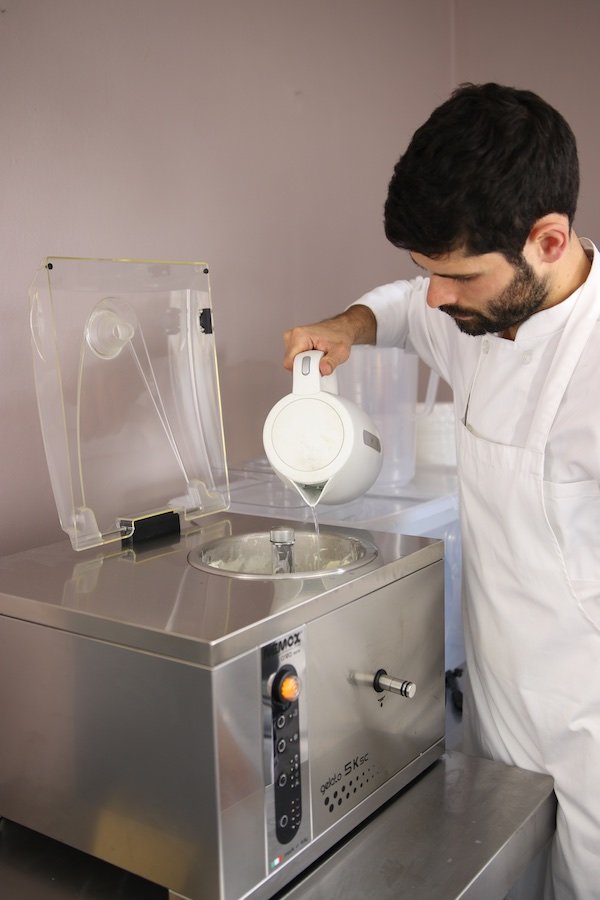
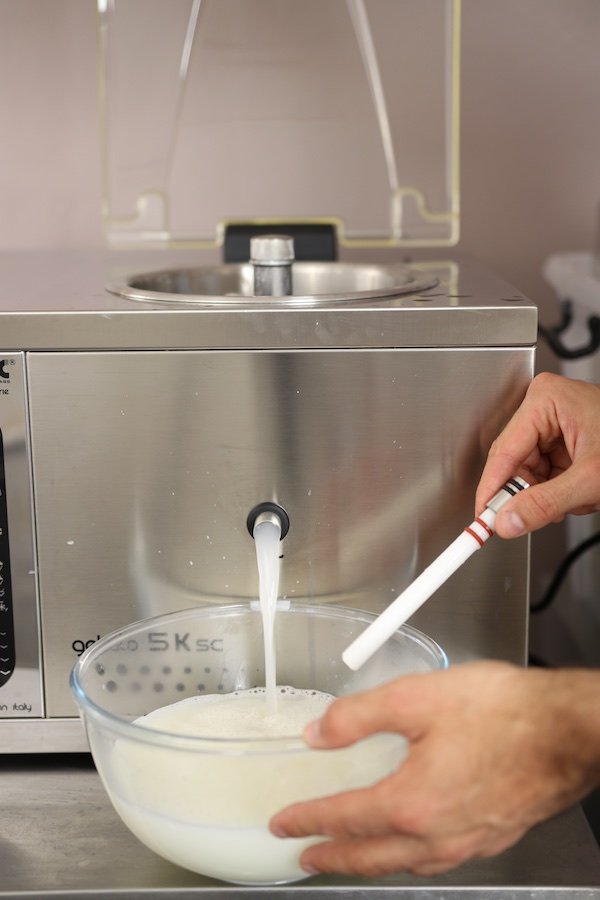 Does the Nemox 5k Crea make good ice cream?
Does the Nemox 5k Crea make good ice cream?
Yes I've found that the Nemox 5K Crea makes exceptional ice cream that is extremely thick, dense, and creamy. This creamy texture is, in part, a result of the smaller ice crystals, air bubbles, and fat globule aggregates, as well as the higher degree of foam stability (fat globule destabilisation), that result from low draw temperatures of between -10°C and -12.1°C (14°F and 10.22°F), as well as the short 12 minute residence time. A sensory panel of 5 untrained assessors (the 5 carpenters who share the building my kitchen unit is in and have kindly volunteered to be my taste testers) described the ice cream as 'dense', 'thick', and 'really creamy', and as 'melting slowly in the mouth'.
4. My only complaint
My only complaint about this machine is that the dasher could be better designed to disperse the mix against the cold barrel wall as it freezes. I've noticed that as the ice cream mix starts to harden, it tends to clump against the dasher in the centre of the barrel where warmer temperatures cause rapid recrystallisation and growth. I've noticed that after 12 minutes of freezing, ice cream in the centre of the barrel is at temperatures between -9°C and -10°C (15.8°F and 14°F), whereas ice cream closer to the cold barrel wall is -12.1°C (10.22°F). Despite the uneven freezing, I haven't found the warmer ice cream in the centre of the barrel any less creamy than ice cream closer to the barrel wall.
I also don't like the fact that the dasher stops rotating when I open the lid to check the temperature of my ice cream; this is because of a magnetic safety device installed in the lid. Having the dasher stop during freezing causes ice cream to freeze to the barrel wall, which then adds stress to the motor system when I shut the lid and the dasher restarts.
5. Summary
After nearly 1 month of testing, I've found that the [amazon text=Nemox 5K Crea*&asin=B01CJC9G06&asin[uk]=B01LY9N0RM&asin[de]=B00K7CA2YA&asin[it]=B00K7CA2YA] produces exceptional ice cream that is thick, dense, and extremely creamy. The vertical freezer barrel is able to freeze ice cream to draw temperatures of between -10°C and -12.1°C (14°F and 10.22°F), producing ice cream with smaller ice crystals, air bubbles, and fat globule aggregates that is perceived creamier than ice cream extracted at conventional draw temperatures of -5°C and -6°C (23°F and 21.2°F). It has a maximum capacity of 1.25kg, or 1120 ml (1.18 quart), of ice cream mix, producing about 1200 ml (1.27 quart) of ice cream with about 7% air in 12 minutes, although I've managed to freeze 1527g, about 1500ml (1.59 quart) of ice cream mix, producing about 1600ml (1.69 quart) of ice cream with about 7% air in 15 minutes. I've also been impressed by the drainage hole inside the barrel, which makes cleaning quick and easy. My only complaint is that the dasher could be better designed to disperse the mix as it freezes. This would prevent ice cream from clumping in the centre of the barrel, thereby reducing ice crystal growth and recrystallisation.
I hope this review helps. I'd be happy to answer any questions and would love some BRUTALLY HONEST feedback on this review so please do feel free to get in touch and say hi! Ruben :)
6. What The * Means
Transparency is key. On that note, I haven't been paid to write this review, nor was I given this machine for free. I paid for this bad boy with my own money and have written this review in my own time. If there is a * after a link, it means that I will earn a payment if you go through it and make a purchase on amazon. This doesn't increase the cost of what you purchase, nor do these links influence what I write, ever.
References
Arbuckle, W. S., 1977. Ice cream (3rd ed.). Connecticut: Avi Publisher Company.
Ben Lakhdar, M., Cerecero, R., Alvarez, G., Guilpart, J., Flick, D., and Lallemand, A., 2005. Heat transfer with freezing in a scraped surface heat exchanger. Applied Thermal Engineering. 25(1), 45–60.
Berger, K. G,, Bullimore, B. K., White, G. W., and Wright, W. B., 1972. The structure of ice cream – Part 1. Dairy Industries, 37(8), 419-425.
Bolliger, S., 1996. Freeze structuring in food systems under mechanical energy input. Dissertation no. 11914, Department of Food Science, ETH, ZuK rich, Switzerland.
Bolliger, S., Goff, H. D., and Tharp, B. W., 2000a. Correlation between colloidal properties of ice cream mix and ice cream. Int. Dairy J. 10:303–309.
Bolliger, S., Kornbrust, B., Goff, H. D., Tharp, B. W., and Windhab, E. J., 2000b. Influence of emulsifiers on ice cream produced by conventional freezing and low-temperature extrusion processing. Int. Dairy J. 10:497–504.
Caillet, A., Cogne, C., Andrieu, J., Laurent, P., and Rivoire, A., 2003. Characterization of ice cream structure by direct optical microscopy. Influence of freezing parameters. Lebensm Wiss U Technol. 36:743–749.
Caldwell, K.B, Goff, H. D., and Stanley, D. W., 1992. A low-temperature scanning electron-microscopy study of ice cream 1. Techniques and general microstructure. Food Struct. 11(1):1–9.
Cook, K. L. K., and Hartel, R. W., 2010. Mechanisms of Ice Crystallisation in Ice Cream Production. Comprehensive Reviews in Food Science and Food Safety. 9(2).
Cook, K. L. K., and Hartel, R. W., 2011. Effect of freezing temperature and warming rate on dendrite break-up when freezing ice cream mix. International Dairy Journal. 21(6).
Donhowe, D. P., Hartel R. W., and Bradley R.L., 1991. Determination of ice crystal size distributions in frozen desserts. Journal of Dairy Science. 74.
Donhowe, D. P., and Hartel, R. W., 1996. Recrystallization of ice during bulk storage of ice cream. Int Dairy J. 6(11–12):1209–21.
Donhowe, D. P. (1993) Ice Recrystallization in Ice Cream and Ice Milk. PhD thesis, University of Wisconsm-Madison.
Drewett, E. M., and Hartel, R. W., 2007. Ice crystallisation in a scraped surface freezer. Journal of Food Engineering. 78(3).
Eisner, M. D., Wildmoser, H., and Windhab, E. J., 2005. Air cell microstructuring in a high-viscous ice cream matrix. Colloids Surf A. 263(1–3). 390–9.
Fennema, O. R., Powrie, W. D., Marth, E. H., 1973. Low Temperature Preservation of Foods and living Matter. USA: Marcel Dekker, Inc.
Flores, A. A., and Goff, H. D., 1999a. Ice crystal size distributions in dynamically frozen model solutions and ice cream as affected by stabilizers. Journal of Dairy Science. 82. 1399–1407.
Flores, A. A., and Goff, H. D., 1999b. Recrystallization in ice cream after constant and cycling temperature storage conditions as affected by stabilizers. Journal of Dairy Science. 82, 1408–1415.
Goff, H. D., and Hartel R. W., 2013. Ice Cream. Seventh Edition. New York Springer.
Hagiwara, T., and Hartel, R. W. 1996. Effect of sweetener, stabilizer, and storage temperature on ice recrystallization in ice cream. J Dairy Sci. 79(5):735–44.
Hartel, R. W., 1996. Ice crystallisation during the manufacture of ice cream. Trends in Food Science & Technology. 7(10).
Hartel, R. W., 2001. Crystallisation in foods. Gaithersburg, MD: Aspen Publishers.
Inoue, K., Ochi, H., Taketsuka, M., Saito H., Sakurai, K., Ichihashi, N., Iwatsuki, K., and Kokubo, S., 2008. Modelling of the effect of freezer conditions on the principal constituent parameters of ice cream by using response surface methodology. Journal of Dairy Science. 91(5). 1722-32.
Kusumaatmaja, W., 2009. Effects of mix pre-aeration and product recirculation on ice cream microstructure and sensory qualities [MSc thesis]. Madison, WI: University of Wisconsin – Madison. p.136.
Koxholt, M., Eisenmann, B., and Hinrichs, J., 2000. Effect of process parameters on the structure of ice cream. Bur Dairy Mag. 1:27-30.
Marshall, R. T., Goff, H. D., and Hartel R. W., 2003. Ice cream (6th ed). New York: Kluwer Academic/Plenum Publishers.
Russell, A. B., Cheney, P. E., and Wantling, S. D., 1999. Influence of freezing conditions on ice crystallisation in ice cream. Journal of Food Engineering. 29.
Sofjan, R., P., and Hartel, R. W., 2004. Effects of overrun on structural and physical characteristics of ice cream. International Dairy Journal. 14, 255-262.
Soukoulis, C., and Fisk, I., 2016. Innovative Ingredients and Emerging Technologies for Controlling Ice Recrystallization, Texture, and Structure Stability in Frozen Dairy Desserts: A Review, Critical Reviews in Food Science and Nutrition, 56:15, 2543-2559,
Wildmoser, H., Scheiwiller, J., and Windhab, E. J., 2004. Impact of disperse microstructure on rheology and quality aspects of ice cream. Food Sci. Technol. 37:881–891.
Windhab, E., and Bolliger, S., 1998a. Low temperature ice-cream extrusion technology and related ice cream properties. European Dairy Magazine, 10, p.24-28.
Windhab, E. J., and Bolliger, S., 1998b. New developments in ice-cream freezing technology and related on-line measuring techniques. In W. Buchheim, Ice cream (p. 112-130). Special Issue 9803, Brussels, Belgium: International Dairy Federation.
Windhab, E. J., Wildmoser, H. et al., 2001. Production en continu de crème glacée, Revue Genèrale Du FROID, 1011. 49-54.

